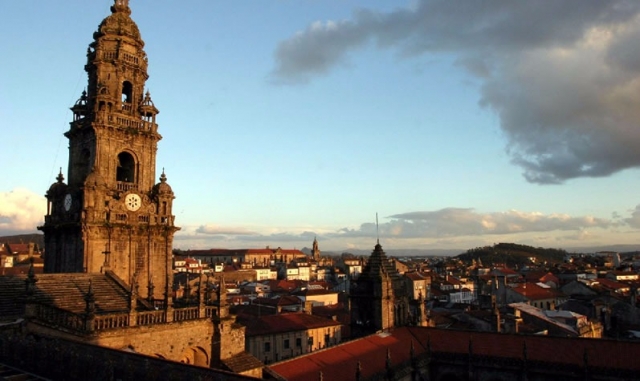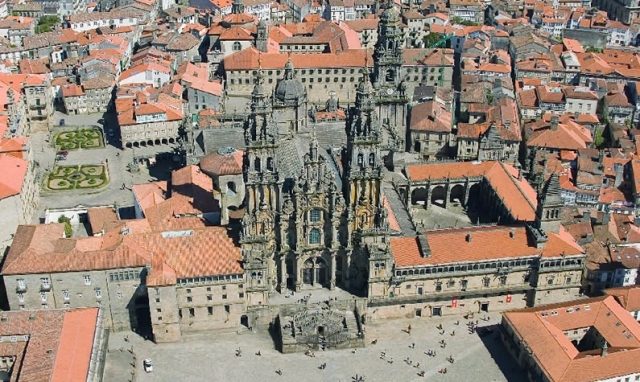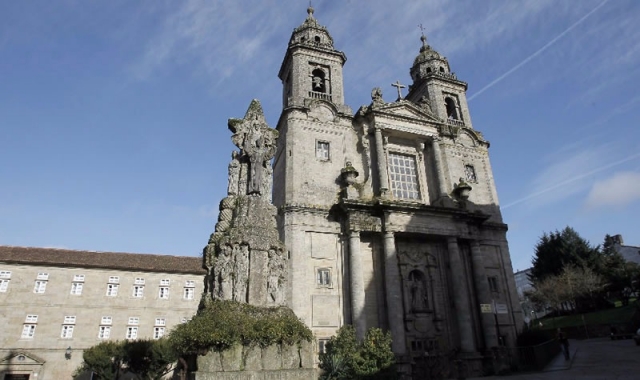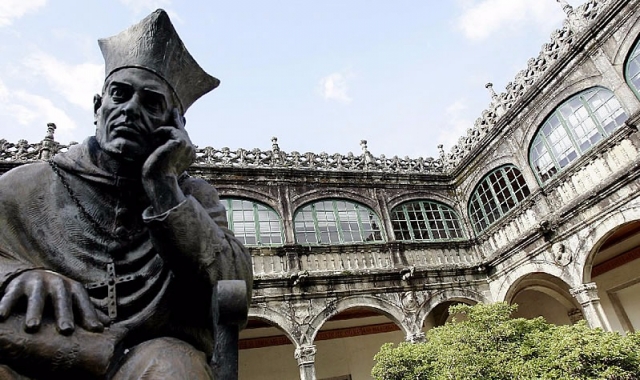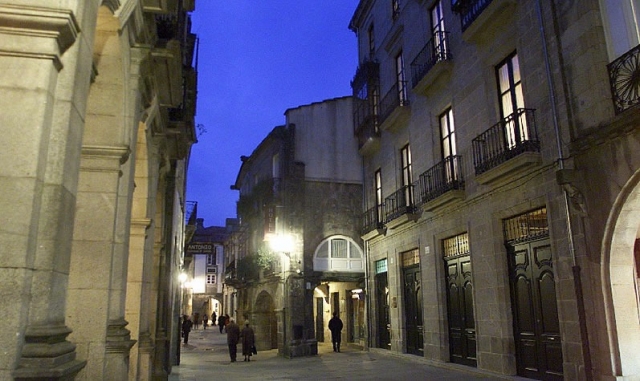What to see
Guide to Santiago
Santiago, the end of the road and above all monumental town is worth a relaxed visit. Below is a description of the heritage that will be encountered by pilgrims on their arrival to the historic centre as well as other locations, which despite being located at some distance from Jacobean route, also deserves to be visited.
The ancient route continues along Rúa de San Pedro, a cobbled street and home to the majority of hospitality establishments and cultural activity in Compostela. After walking down it, and now at the edge of the monumental city, on turning to the right (off the Jacobean route) travellers will come to the Centro Galego de Arte Contemporánea (The Galician Centre of Contemporary Art) (CGAC) – a building of exhibitions erected by the Portuguese architect Alvaro Siza in 1993 – and, opposite, to the right, is the former convent of Santo Domingo de Bonaval, built in the XIII century by the pilgrim Saint Domingo of Guzmán. Its walls have contained, since 1977 the Museum of Pobo Galego, a portrait of ethnographic Galicia with wide and varied pieces of art and traditional crafts inspired by the sea or by popular architecture. In the museum a beautiful triple spiral staircase stands out, a great piece of daring architecture, a unique example of the heritage of Compostela, it is also one of the most photographed. The museum can be visited from Tuesday to Saturday from 10.00 to 14.00 and from 16.00 to 20.00 and, on Sundays from 11.00 to 14.00. The adjoining church, built in the XIV century in Gothic mendicant style, has three naves separated by arches. Located in a side chapel is the Pantheon of Illustrious Galicians, where prominent figures stand out in the memory of Galicians and Galician cultural, writers such as Rosalía de Castro, Castelao, Alfredo Brañas and Ramón Cabanillas as well as the sculptor Francisco Asorey.
From the passage way between the walls of the Museum CGAC and the Museum of Pobo Galego the pilgrims will enter one of most charming garden enclosures, the perfect setting for various artistic works. Namely, the park of Santo Domingo de Bonaval, formerly it was the garden and cemetery of the Dominican convent. A project that was also undertaken by the architect Alvaro Siza and the landscape architect Isabel Aguirre. It is a beautiful park of contemporary design where visitors have an excellent view of the rooftops of the city (the best view is from the top of the old cemetery). At the bottom, in the area once used by the monks as a vegetable garden, stands a statue of Eduardo Chillida known as La puerta de la musica (the door of music).
Now back on the pilgrim path walkers reaches the Porta do Camino, one of the seven historic entrances to the ancient walled city of Santiago. The route then enters the historical centre along its calle Casas Reais, named so for previously containing royal housing and, where formally the guild of monetary exchange was located. From here the pilgrims will discover the imposing Chapel de las Animas, with its neoclassical façade, built by alms from the devotees of souls in purgatory. Inside they keep an important collection of religious art.
After this visit walkers head towards the Plaza de Cervantes, the first major historical meeting and trading place in the city and home to the late eighteenth century town hall. A statue of the famous author of Don Quixote crowns its fountain. This place was known as, in the XII century, El Foro (the Forum), for being where the town crier read municipal agreements.
The travellers continue down the street of A Acibechería, where the majority of jet stone artisans can be found.
The Arabs had already empowered the use of this black mineral although it was in the XIIII century, and linked to the pilgrimage to Santiago, when a great development of Azabachería was produced. In Compostela, the concheiros (the guild devoted to selling scallop shells to newly arrived pilgrims) decided to use the stone, and produced daunting quantities that lasted for several centuries. Even today there are numerous silversmiths shops in Compostela dedicated to the production of this semi-precious stone.
Soon after, and following a right turn, visitors can continue along rúa da Troia, a narrow street full of bars and tapas establishments. It is also home to the literary Casa de la Troya, a former student hostel immortalized by Perez Lugín in the novel of the same name. This book, of 1915, narrates the adventures and misadventures of university life in Compostela during the XIX century. The building also houses the Museum of Casa da Troia, built in the mid-XVIII century. On the first floor the old dining hall has been maintained, this room also functioned as a study area and here during the golden age the house hosted the rehearsals of Compostelana Tuna (a student musical group). On the second floor are the bedrooms while in the attic, with great views over the historic centre of Compostela; they have retained the kitchen and a small bedroom. The basement was once used as stable for horses but is currently used by the university tunas as a practice area, here visitors can admire various musical instruments. The museum, managed by the Association de Antigos Tunos Composteláns, can only be visited in the summer. In 2013, it reopened its doors on July 2nd. Opening hours are from Tuesday to Saturday from 11.00 to 14.00 and from 16.00 to 20.00 hours (on Fridays, until 22.00 hours) and on Sundays it only opens in the morning. For more information: (+34) 981 585 159.
After continue along the Rua da Troia visitors arrive to San Martiño Pinario Square, where the facade of the church of the monastery is situated. This temple, built in the XVI century and, aside from the cathedral is the best example of Galician baroque architecture, notable for its plateresque façade and its highest pediment, where San Martin can be seen sharing his cloak with a poor man. The baroque staircase and the towers of a well considered height so as not to exceed those of the cathedral, are two of its most characteristic elements. Inside the Baroque altarpiece and the choir stalls stand out, made of walnut, they are considered to the most important in Galicia. The church only celebrates worship for private ceremonies and during special events.
After bordering around the left side of this monastery walkers come to the main door located in front of the facade of Acibechería of the Cathedral of Compostela. The monastery was founded by a group of Benedictines transferred to the place shortly after the discovery of the supposed remains of Santiago. Vast in size, it is the second largest monastery in Spain after El Escorial. The monument underwent the majority of its development in the XV century and it was in the XIX century when it ceased to be a monastery. Its design illustrates a great simplicity of lines, notable for its facade and access staircase, and for its Doric columns that frame the portal. Among the figures represented is Saint Martiño of Tours. Currently the inside of the building is used for various functions, such as a Seminary, a school of Social studies, for theological Studies, a diocese archive and a university hall of residence.
Obradoiro Square
If pilgrims continue their descent through the arch they will arrive at Plaza del Obradoiro in which they will usually hear the sound of a bagpiper to accompany them on their journey. From here they will arrive at the beautiful square where the majority of silversmiths of this ancient town can be found. On the right the Hostel dos Reis Catolicos stands majestically, today it is a national Parador (high class hotel) and, the former Royal Hospital for pilgrims. Next to it, and in front of the cathedral is the Pazo de Raxoi, the Town Hall of Compostela. On its left is the College of San Xerome, home of the rector of the centennial university and, crowning the square, is the west facade of the cathedral, baroque in style, the most photographed monument by all the pilgrims.
The Hostal dos Reis Catolicos deserves a special mention, its construction was ordered on the 3rd of May in 1499 by the monarchs Isabel and Fernando, who, after a visit to Compostela, noted a lack of health care for pilgrims. In its hay day the Royal Hospital boasted the most advanced equipment for its time, as well as the best doctors, assistants and a good chemist. According to chronicles pilgrims were even attended to in more than half a dozen European languages. However, the complex subsequently suffered neglect and, later food was the only aid they could provide to pilgrims. There are also claims that, at certain times, overcrowding led to three pilgrims having to share just one bed.
The building is most notable for its beautiful façade, plateresque in style with a handmade door and a triumphal arch, upon which there are two medallions with the statues of the monarchs. On the frieze is the royal Chamber window, reserved for monarchs on their visits to Compostela. Attention should also be paid to the curious gargoyles that adorn the cornice. Inside its four courtyards and a beautiful Gothic chapel with a cross and a beautifully crafted vault stand out.
Since the mid- XX century the complex became a luxurious parador, considered by many to be the world’s oldest hotel, with elegant rooms and a luxurious dining room. Although it still retains today its hospitable custom in memory of its origins as a hostel for pilgrims. The hotel offers those pilgrims first to arrive, ten breakfast, ten lunches and ten dinners, totally free of charge, once they have presented the credential to demonstrate that they have completed the Camino. Frequently, they raffle off the meals to pilgrims in the queue in Obradoiro Square.
The College of San Xerome, built in the XVI century under the order of Bishop Fonseca who created a space for poor students of art. Renaissance in style, its late Gothic portal once belonged to former pilgrim hospital located previously in Azabachería.
A French engineer constructed the Pazo of Raxoi, of neoclassical design, in the XVIII century. Among its uses it served as confessors department, a residence for the choir children of the cathedral and, as a civil prison. In its tympanum they have retained images of the Battle of Clavijo, a story well known along the French route during which, according to legend, the divine intervention of the Apostle, presented the first image of the apostle as Santiago Matamoros, helping to win the battle against the Muslim invasion.
Convent of San Francisco
If pilgrims leave on the left the hotel-Hostal dos Reis Catolicos- and proceed along calle San Francisco they will come to the majestic Faculty of Medicine (constructed between 1910 and 1928) and, a few meters later, a monument to San Francisco by the sculptor Francisco Asorey and, behind the sculpture, to the Convent of San Francisco itself, a Franciscan monastery built in the XIII century. According to tradition the Saint embarked on a pilgrimage to Compostela in 1214 and was the founder of this holy temple. Beyond the diverse theories fuelled by popular imagination, the only certainty is preserved on a plaque at the entrance of the convent. For your interest, the plaque reads. ” Our Father San Francisco upon visiting the Apostle Santiago, was given refuge by a poor coal worker called Cotolay, whose house was next to the chapel of San Paio in the foothills of Mount Pedroso. From there the holy saint went to the mountains to spend the evenings in prayer. There God revealed himself and asked that he build a convent at this site called Val of God or Val of Hell, and knowing the Saint was of the monastery of San Martin requested that he ask the abbot, for his love in God to instruct and support him to do so and in return, he would pay a basket of fish every year. Father Abbot accepted and signed in the Holy forum, which was witnessed and agreed by the elders of San Martin. The saint returned to Cotolay and said, “God wants you to build me a monastery of my order.” Cotolay replied that how could a poor coal worker do that- “Go to that fountain” – said the Saint – there God will give you the means to obey-. Cotolay did as instructed and found a great treasure with which he built the monastery. God blessed Cotolays house; he married, became the mayor of the city and built the walls that now surround San Francisco and that previously were around Azabachería. His wife is buried in the Quintana and Cotolay, founder of this house, died holily in the year of our Lord in 1238. ”
From the original convent only five arches have been preserved, previously they were situated in the Chapter House where King Charles V held courts in 1520, and these can now be admired in the cloister, as well as the tomb of Cotolay. Reconstruction of the remains took place after 1742.
Pazo de Fonseca
Back in the Plaza del Obradoiro, and if pilgrims go in the opposite direction then they will reach the Pazo de Fonseca, an educational monument constructed by the Archbishop Alonso de Fonseca and which became operational in the XVI century. It formed part of the university. Also notable within the grounds, next to the Renaissance façade, are the cloister, the Gothic chapel and a panelled lounge, which hosts temporary exhibitions. On the first floor there is an American Library, an authentic museum with material specializing on Latin America, it has become one of the most important in the country. In total it contains 30,000 bibliographic jewels. For several years the building has also formed part of the public Library, one of the busiest places of study for students during exam periods.
Plaza de Platerías
If the pilgrims return to the area surrounding the cathedral and walk round until reaching the Romanesque silver façade, then they can admire the beautiful Square, which owes its name to the silversmith workshops located here in the Middle Ages. In the centre the famous Fuente de los Caballos (Fountain of the Horses) stands out. The fountain, made of granite, includes a female figure holding up the star of Compostela. A tradition of pilgrims is to toss a coin into the water in order to be granted a wish.
Also in the square is the Museo das Peregrinacións (Museum of pilgrimages), opened in 2012. It contains several exhibitions related to the history of Santiago and the Camino. It’s worth going to the cafe from where there is a remarkable view of the tower of Berengaria of the cathedral.
Plaza de A Quintana
On continuing around the squares that surrounding the cathedral they will arrive to A Quintana, an imposing open space next to the temple, closed off to the east by the wall of the monastery of San Paio of Antealtares. The most striking thing about the enclosure is its division into two parts. At the lower part, known as Quintana of Mortos (Quintana of the dead), deceased residents of Santiago were buried until 1780 when, due to a lack of space, they began using the cemetery of Santo Domingo de Bonaval. The higher part is known, by contrast, as (Quintana of the Living).
Almost in the vicinity, although still at the outskirts, is the park of Alameda, from the XIX century, it is without doubt the most traditional urban garden and, an area of leisure for residents of Compostela. The park is most notable for the arrangement of its central promenade with different paths for different social classes from 200 years ago. Also notable for its triumphal arch that leads around the Paseo de los Leones, on one of the benches there is a figure of the famous Galician writer Valle Inclán. On continuing the route travellers will have the chance to admire one of the most beautiful views of the historic area. Including a great variety of tree species, as well as oak and chestnut trees from India, also it boasts the oak wood (Carballeira in Gallego) of Santa Susana, with its own chapel. Pilgrims will discover, in the park, a beautiful music box, young palm trees and, at the entrance, the colourful figure of Dos Marias (two Marias), Maruxa and Coralia Fandiño, two sisters who have become part of living history and even recent history in Compostela. The elderly women, from Santiago are remembered for dressing to the nines and, with striking makeup. Whenever the clock struck two o’clock they would begin their daily walk through the Alameda and ‘would meet’ with the new generations of students. Both coming from a political left thinking background left, during the Franco years they were humiliated and consequently adopted, as a mechanism of defence, a particular way of life.
Routes
Blog
 How to get to Sarria to do the Camino de Santiago
How to get to Sarria to do the Camino de Santiago
 Descubre la magia del Camino de Santiago Portugués por la costa
Descubre la magia del Camino de Santiago Portugués por la costa
 5 tours culturales que puedes hacer en Galicia si decides hacer un alto en el camino
5 tours culturales que puedes hacer en Galicia si decides hacer un alto en el camino
 Doing the Camino de Santiago in June: What you should know?
Doing the Camino de Santiago in June: What you should know?
Information
Points of interest
Cities & Towns | Hostels | Lodgings | Restaurants | Saddlery | Doctors | Points of interest | Bikes workshop
Contact us | Privacy policy | Cookies policy | | Terms of use | Authorship | Web Map | Consentimiento
© Copyright LA VOZ DE GALICIA S.A. Polígono de Sabón, Arteixo, A CORUÑA (ESPAÑA) Inscrita en el Registro Mercantil de A Coruña en el Tomo 2438 del Archivo, Sección General, a los folios 91 y siguientes, hoja C-2141. CIF: A-15000649
Developed and managed byHyliacom
